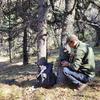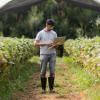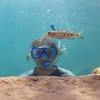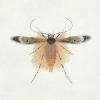Autonomous camera traps for insects provide a tool for long-term remote monitoring of insects. These systems bring together cameras, computer vision, and autonomous infrastructure such as solar panels, mini computers, and data telemetry to collect images of insects.
With increasing recognition of the importance of insects as the dominant component of almost all ecosystems, there are growing concerns that insect biodiversity has declined globally, with serious consequences for the ecosystem services on which we all depend.
Automated camera traps for insects offer one of the best practical and cost-effective solutions for more standardised monitoring of insects across the globe. However, to realise this we need interdisciplinary teams who can work together to develop the hardware systems, AI components, metadata standards, data analysis, and much more.
This WILDLABS group has been set up by people from around the world who have individually been tackling parts of this challenge and who believe we can do more by working together.
We hope you will become part of this group where we share our knowledge and expertise to advance this technology.
Check out Tom's Variety Hour talk for an introduction to this group.
Learn about Autonomous Camera Traps for Insects by checking out recordings of our webinar series:
- Hardware design of camera traps for moth monitoring
- Assessing the effectiveness of these autonomous systems in real-world settings, and comparing results with traditional monitoring methods
- Designing machine learning tools to process camera trap data automatically
- Developing automated camera systems for monitoring pollinators
- India-focused projects on insect monitoring
Meet the rest of the group and introduce yourself on our welcome thread - https://www.wildlabs.net/discussion/welcome-autonomous-camera-traps-insects-group
Group curators
- @tom_august
- | he/him
Computational ecologist with interests in computer vision, citizen science, open science, drones, acoustics, data viz, software engineering, public engagement



- 8 Resources
- 54 Discussions
- 5 Groups



- 9 Resources
- 2 Discussions
- 9 Groups
No showcases have been added to this group yet.
Ecologist at Noe NGO, Project manager in restauration, rewilding, and citizen sciences program for grassland ecosystems and wild pollinators

- 0 Resources
- 1 Discussions
- 7 Groups
- @capreolus
- | he/him
Capreolus e.U.
wildlife biologist with capreolus.at





- 1 Resources
- 78 Discussions
- 16 Groups
Research software engineer working in computer vision for animal behaviour
- 1 Resources
- 1 Discussions
- 13 Groups
Professor of Computer Science researching theory and application of technology to insect pollination and management in natural and agricultural ecosystems.
- 0 Resources
- 2 Discussions
- 1 Groups
- @ppalencia
- | Dr
I am Pablo Palencia, a postdoctoral researcher at Biodiversity Research Institute (IMIB). I am interested on develop and fine-tuning cutting-edge tools for wildlife management and conservation, wit a special mention of camera trapping ;)
- 0 Resources
- 0 Discussions
- 7 Groups
Natural Solutions
Computational ecologist - Engineer at Natural Solutions (France)



- 0 Resources
- 1 Discussions
- 13 Groups
- @Gcharron
- | Mr.
Cofounder of Outreach Robotics, I have a master in mechanical engineering and I thrive on developing new technology for field scientists using remote controlled robots.


- 1 Resources
- 15 Discussions
- 4 Groups
- @avilabon
- | He/Him/His
My name is Albert Vila, and I have a multidisciplinary background in earth sciences, design, and technology. I hold degrees in Environmental Sciences, GIS, Bioarchitecture, and Emerging Futures Design. My work focuses on biodiversity, natural areas, and technology.
- 0 Resources
- 0 Discussions
- 5 Groups
A researcher from Monash University working on developing Computer Vision facilitated insect monitoring systems for agriculture and entomology.


- 0 Resources
- 3 Discussions
- 2 Groups
Wildlife Drones
Wildlife Drones has developed the world’s most innovative radio animal-tracking system using drones so you can track your radio-tagged animals like never before.


- 18 Resources
- 8 Discussions
- 31 Groups
Research technician at the New Zealand Arthropod Collection. Interests include combining machine learning and computer vision in entomology.
- 0 Resources
- 0 Discussions
- 1 Groups
- 0 Resources
- 0 Discussions
- 3 Groups
Come and do the first research into responsible AI for biodiversity monitoring, developing ways to ensure these AIs are safe, unbiased and accountable.
11 June 2024
€4,000 travel grants are available for researchers interested in insect monitoring using automated cameras and computer vision
6 June 2024
WildLabs will soon launch a 'Funding and Finance' group. What would be your wish list for such a group? Would you be interested in co-managing or otherwise helping out?
5 June 2024
Do you have photos and videos of your conservation tech work? We want to include them in a conservation technology showcase video
17 May 2024
€2,000 travel grants are available for researchers interested in insect monitoring using automated cameras and computer vision
3 May 2024
Article
Read in detail about how to use The Inventory, our new living directory of conservation technology tools, organisations, and R&D projects.
1 May 2024
Article
The Inventory is your one-stop shop for conservation technology tools, organisations, and R&D projects. Start contributing to it now!
1 May 2024
The Smithsonian National Zoo & Conservation Biology Institute is seeking a Postdoctoral Research Fellow to help us integrate movement data & camera trap data with global conservation policy.
22 April 2024
We invite applications for the third Computer Vision for Ecology (CV4E) workshop, a three-week hands-on intensive course in CV targeted at graduate students, postdocs, early faculty, and junior researchers in Ecology...
12 February 2024
The primary focus of the research is to explore how red deer movements, space use, habitat selection and foraging behaviour change during the wolf recolonization process.
10 February 2024
Outstanding chance for a motivated and ambitious individual to enhance their current project support skills by engaging with a diverse array of exciting projects in the field of biodiversity science.
11 December 2023
Two-year postdoc in AI and remote sensing for citizen-science pollinator monitoring, at Aarhus University. The successful candidate will integrate our computational entomologist team to develop and deploy novel methods...
4 December 2023
December 2023
event
November 2023
| Description | Activity | Replies | Groups | Updated |
|---|---|---|---|---|
| Gotcha, well I look forward to seeing future iterations and following along with your progress!! |
|
Autonomous Camera Traps for Insects, AI for Conservation, Emerging Tech, Open Source Solutions, Latin America Community | 1 year 3 months ago | |
| More cool things surrounding the Mothbox project keep happening! Here’s a recap of cool developments over the past month!New Teammate! Bri... |
|
Autonomous Camera Traps for Insects, Latin America Community | 1 year 3 months ago | |
| For our [mothbox project](https://forum.openhardware.science/c/projects/mothbox/73) we are programming pijuices and pis to automatically... |
|
Autonomous Camera Traps for Insects | 1 year 4 months ago | |
| Hi, I made a little utility script that folks here might find useful (or might have MUCH BETTER VERSIONS OF! and if so, let me know!) ... |
|
Autonomous Camera Traps for Insects | 1 year 5 months ago | |
| We did some more testing with the Mothbeam in the forest. It's the height of dry season right now, so not many moths came out, but the mothbeam shined super bright and attracted a... |
|
Autonomous Camera Traps for Insects, Latin America Community | 1 year 5 months ago | |
| Hi Danilo, yes just in time ;-) |
|
Camera Traps, Autonomous Camera Traps for Insects | 1 year 6 months ago | |
| Yep, here:Currently it only installs on older Jetsons as in the coming weeks I’ll finish the install code for current jetsons.Technically speaking, if you were an IT specialist... |
|
Autonomous Camera Traps for Insects, Camera Traps | 1 year 7 months ago | |
| Great work! I very much look forward to trying out the MothBeam light. That's going to be a huge help in making moth monitoring more accessible.And well done digging into the... |
|
Autonomous Camera Traps for Insects, Latin America Community | 1 year 7 months ago | |
| The preprint to our camera trap paper is now available at bioRxiv. |
+23
|
Autonomous Camera Traps for Insects | 1 year 8 months ago | |
| Thanks a lot for this detailed update on your project! It looks great! |
|
Autonomous Camera Traps for Insects, Latin America Community | 1 year 9 months ago | |
| It depends on which scientists you talk to. I am an favor of just doing a timelapse and doing a post-processing sort afterwards. There's not much reason i can see for such motion... |
|
Autonomous Camera Traps for Insects, Latin America Community | 1 year 9 months ago | |
| For anyone interested: the GBIF guide Best Practices for Managing and Publishing Camera Trap Data is still open for review and feedback until next week. More info can be found in... |
|
Autonomous Camera Traps for Insects, Camera Traps | 1 year 9 months ago |









































